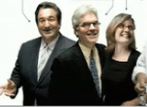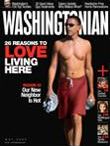 The who’s who – and how – of D.C.’s Top 100 Techies is all the buzz in the local tech community: who’s on the list, who’s not, how wide and/or deep the list is, etc. I was delighted to be named a Tech Titan (see here) but I’ve been curious… how did editor-at-large Garrett Graff choose 100 noteworthy D.C. techies for the May 2009 issue of Washingtonian?
The who’s who – and how – of D.C.’s Top 100 Techies is all the buzz in the local tech community: who’s on the list, who’s not, how wide and/or deep the list is, etc. I was delighted to be named a Tech Titan (see here) but I’ve been curious… how did editor-at-large Garrett Graff choose 100 noteworthy D.C. techies for the May 2009 issue of Washingtonian?
Below (left to right) are three Tech Titans: Ted Leonsis, Mark Walsh and Jill Foster.
 Graff’s street cred for compiling such a list is impressive, BTW. He worked for Joe Trippi as Howard Dean’s first Webmaster. His first book, The First Campaign (about the digital race for the White House) was reviewed by the New York Times. And he’s at work on a second book about the story behind the internationalization of the FBI (based on articles he’s written for the magazine here and here.)
Graff’s street cred for compiling such a list is impressive, BTW. He worked for Joe Trippi as Howard Dean’s first Webmaster. His first book, The First Campaign (about the digital race for the White House) was reviewed by the New York Times. And he’s at work on a second book about the story behind the internationalization of the FBI (based on articles he’s written for the magazine here and here.)
Oh and he’s 27. Grrr…
Garrett kindly agreed to answer a few questions:
DW: Whose idea was it to create a Tech Titans list for DC?
GMG: We had talked about doing such a list for a while. Who are the people trying to shape the world of technology in greater Washington? We try to do this across a lot of sectors, to give people the knowledge of who they should be watching. As Jack Limpert (long-time Washingtonian editor) says, “You can’t tell the players without a program.”
DW: How did you go about it and how long did it take?
GMG: It took about three months to put together. I started with a core of people that are very familiar, names like Ted Leonsis, who were automatic candidates. They’re very well connected and influential. What I did was to interview that group and asked them who they considered influential, who did they listen to, who did they pay attention to when they started a new company, who did they invest with.
Then I worked out in ever concentric circles from that group. I probably did about 70 interviews.
DW: Did you have a formula for including the lesser known on the list? For example, if other influencers mentioned their names at least two or three times?
GMG: No, it wasn’t a specific number of mentions of anyone that put them on or kept them off the list. There were some people I interviewed who didn’t end up making the list themselves.
In researching, interviewing, and reporting the piece, I wasn’t looking for a magic threshold of influence. Instead, I focused on the case specifics for each individual and whether there was a compelling reason for that person to appear on the list.
Sometimes people made it on the list because of a single endorsement or conversation and others didn’t make the list despite repeated mentions. I won’t pretend that it was a highly scientific process, yet it was geared towards producing a list as diverse, wide-ranging, and deep as the tech community here.
(Full disclosure: Garrett did not interview me for the list.)
DW: One of the most interesting things about the list are the five categories you came up with (Entrepreneurs, Industry Leaders, Dealmakers, Politicos and Community and Thought Leaders). They’re reflective of how diverse the tech community is here and how diverse working Washington is.
GMG: I didn’t start out with those categories in mind but they evolved over the course of reporting the story. Candidates fit very neatly into one category of another; there was very little overlap.
DW: Shouldn’t President Obama be on D.C.’s Tech Titans list?
GMG: We debated that quite a bit…
DW: What surprised you the most in compiling the list?
GMG: I was just amazed at the depth and breadth of the technology sector here. I knew that tech was a big thing going into the piece but I just had no idea how big.
It gave us a ton of (future) story ideas, about companies, ideas and people we should write about in more depth.
Ten years ago, the Washington region was so dominated by AOL, but there’s not a single (current) AOL executive on the list. AOL is no longer where the energy is. The talent and money that they lured here has spawned this tremendous network of people and companies and startups.
DW: Were you surprised by the number of Government 2.0 players in town?
GMG: We get so focused on private tech investment but we have all these government CIOS (the DOD has a $38 billion* information technology budget, for example). These are government officials most people have never heard of and they have a tremendous influence on how technology advances based on the spending decisions they make.
DW: Any other comments about compiling the Top Techies?
GMG: One of the funny parts of these lists is that it’s vastly more work to compile a list of people than to go out and write an article about a person. You have to so much reporting for each sentence. You end up leaving a tremendous amount on the cutting room floor. This list could have been 200 people. There’s even more depth and breadth that what we were able to capture. We left out green tech and biotech.
DW: I know President Obama is on the cover of the May ’09 issue (in much discussed red cutoffs**). But shouldn’t the first Blackberry-carrying President also be on D.C.’s Tech Titans list?
GMG: We debated that quite a bit. He certainly has done more to change the perception of government and technology in the last year than anyone else in the world. Ultimately we came down on the side of recognizing the people he’s deputized to implement his vision of technology, since he won’t be doing it himself.
 * Haven’t found a link to confirm this but sounds about right.
* Haven’t found a link to confirm this but sounds about right.
** Graff, who’s worked for the Washingtonian for four years, noted that there has been “a tremendous amount of response to the cover. Thousands of comments by email and phone calls and posted on the website. I’ve never seen anything like it.”
Links to the 100 Tech Titans
I’d love to see the complete list posted with links behind all the names. Has someone done this? Anyone want to volunteer?? Here’s the list.

